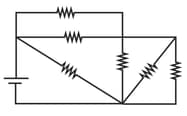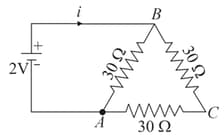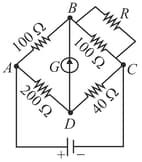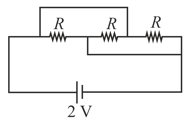In the figure shown each resistor is of and the cell has emf with negligible internal resistance. Then rate of joule heating in the circuit is (in watts)



Important Questions on Current Electricity
Arrange the order of power dissipated in the given circuits, if the same current is passing through the system. The resistance of each resistor is .
i 
ii 
iii 
iv 
Five identical resistors each of resistance are initially arranged as shown in the figure by clear lines. If two similar resistances are added as shown by the dashed lines then change in resistance in final and initial arrangement is

Four identical bulbs each rated , are connected across a battery as shown. The total electric power consumed by the bulbs is:

The current in the circuit of the figure is-

The given Wheatstone bridge is showing no deflection in the galvanometer joined between the points and (Figure). Calculate the value of .

Three equal resistance each of are connected as shown in the figure. A battery of of internal resistance is connected across the circuit. Calculate the value of for which the heat generated in the external circuit is maximum.

